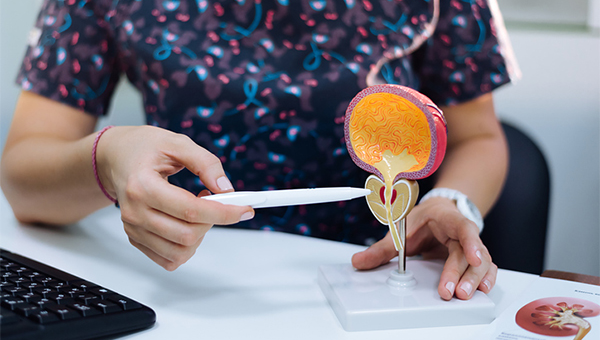Types of incontinence
 16 September 2025
/
16 September 2025
/
 3 minutes
of reading
3 minutes
of reading

There are many classifications of incontinence. They are carried out basing on different criteria. The most common classification was developed by the Standardization Committee of the international organization by the name of ICS (International Continence Society). It is a formal classification which includes also faecal incontinence.
 |
Urinary incontinence |
Stress incontinence
 Is related to the weakening of the pelvic muscles. It is the involuntary urine loss while sneezing, coughing or during physical activity. This type of incontinence in most cases concerns women. It appears in men who had their prostate removed.
Is related to the weakening of the pelvic muscles. It is the involuntary urine loss while sneezing, coughing or during physical activity. This type of incontinence in most cases concerns women. It appears in men who had their prostate removed.
Urge incontinence
 Uncontrolled urine loss preceded by the strong urge to urinate: it can take the form of minor leaks between voluntary urination, or a complete, involuntary bladder voiding.
Uncontrolled urine loss preceded by the strong urge to urinate: it can take the form of minor leaks between voluntary urination, or a complete, involuntary bladder voiding.
Mixed incontinence
Involuntary urine loss occurring during physical exercise, while sneezing, laughing or coughing, combined with the urge to urinate.
Night-time incontinence
Involuntary urine loss during sleep – also known as bedwetting / nocturnal enuresis.
Continuous incontinence
 Continuous involuntary loss of urine.
Continuous involuntary loss of urine.
Reflex incontinence
So called reflex incontinence connected with the nervous system disorders – the patient doesn’t feel the urge to urinate but his bladder voids completely in an uncontrolled way.
Overflow incontinence
 Every urine loss episode is caused by the bladder being overfilled (that might be caused by the urinary outlet blockage).
Every urine loss episode is caused by the bladder being overfilled (that might be caused by the urinary outlet blockage).
Extraurethral (fistular) incontinence
Involuntary urine loss thorough a different way than the urethra.
Undefined incontinence
 Urine loss that cannot be assigned to any other category. This is often used to describe incontinence of the mentally ill who do not have any urinary system dysfunctions.
Urine loss that cannot be assigned to any other category. This is often used to describe incontinence of the mentally ill who do not have any urinary system dysfunctions.
Other types of incontinence
Involuntary urine loss during, for instance, sexual intercourse or after controlled bladder voiding (so called PMD) etc.
 |
Faecal incontinence |
Urge incontinence
 The person feels the urge but is not able to hold it long enough to make it to the toilet – it is often caused by weak muscles of the anal sphincter.
The person feels the urge but is not able to hold it long enough to make it to the toilet – it is often caused by weak muscles of the anal sphincter.
Passive incontinence
The stool happens to leak without the urge to excrete – the most common reasons for this are nerve damage, muscle weakening or chronic constipation.




 Homepage
Homepage

